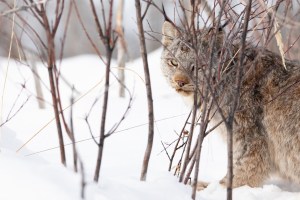An exhaustive survey of Wyoming’s suspected best lynx habitat last winter found no evidence that the rare wildcats still roam the southern Greater Yellowstone Ecosystem.
That’s not a huge surprise. Although a mountain lion houndsman captured photo evidence of a treed lynx in the Gros Ventre Range’s Tin Can Park area in early 2022, federal wildlife officials consider the mid-sized wildcats “functionally extirpated” — meaning extinct from a specific region — in the tri-state ecosystem.
Nevertheless, the Wyoming Game and Fish Department set out to verify that lynx, which are classified as “threatened” under the Endangered Species Act, are indeed no longer residing in the Equality State. During the 2023-’24 winter, they put out 23 camera traps alongside scented and visual lures in the state’s best habitat, which is primarily found along the east slope of the Wyoming Range.
“The cameras have been pulled and we looked through all of the images — there were around 100,000 or so,” Andy Gygli, Game and Fish’s small carnivore biologist, told WyoFile. “We did not locate any lynx on any of those photos. Couple bobcats, but no lynx.”
Gygli basically expected those results. Until the houndsman’s 2022 sighting, the last time lynx were verified in Wyoming was more than a dozen years ago — and it’s not for lack of searching. The Bridger-Teton National Forest spearheaded an extensive multi-jurisdiction 2015 to 2017 survey, conducting 4,000 miles of snowmobile track surveys and monitoring 54 camera traps. Biologists found nothing.
“Every now and then we’ll see a lynx,” Gygli said. “We kind of act as a release valve for these animals that disperse across the landscape, but we don’t really have the correct kind of habitat to support lynx.”
A 2021 habitat modeling study concluded that Wyoming contains much less high-quality lynx habitat than previously thought. Only about 10% of the ecosystem is now considered capable of supporting resident lynx, which require high-densities of snowshoe hares to thrive on the landscape.
This map illustrates the probability of lynx habitat in the northern Rockies. (Ecology and Evolution)
Although Wyoming’s suspected best lynx habitat is relatively limited and currently largely vacant, there are indications that the Greater Yellowstone Ecosystem could serve as a potential “climate refuge” for a snow-dependent species that will lose habitat as the planet heats up. In the Lower 48, lynx are currently most abundant in the New England area, but that habitat is expected to disappear under a middle-of-the-road climate change projection.
The Yellowstone region, in contrast, holds onto over 70% of its habitat by mid-century as the climate warms, according to a U.S. Fish and Wildlife Service species status assessment.
Gygli anticipates Wyoming’s next official lynx survey will be winter of 2028-’29, though it’ll be contingent on funding. Meantime, he encourages anybody who thinks they’ve seen a lynx to report their sighting. A form is available for submitting information and evidence, available at tinyurl.com/wygfd.
There are decent odds that credible reports of lynx will continue to trickle in.
Sublette County resident Jonathan Ratner told WyoFile he’s come across 12 to 14 sets of lynx tracks in the Greater Yellowstone Ecosystem over the past couple of decades.
“I’ve done maybe 7,000 or 8,000 miles of snow track [surveys],” Ratner said. “All over the Wyoming Range, in the Winds and a little bit in the Absarokas.”
Suspected lynx tracks up the Dunoir Creek drainage in the Shoshone National Forest. (Jonathan Ratner)
Ratner’s even seen tracks he deemed lynx just skiing out of his house in the Upper Green River drainage during the last three winters. Trying to get those tracks verified by federal officials has been challenging, he said, but he’s convinced there are more lynx out there in Wyoming than some biologists believe.
“The agencies always say anything that is found is transitory,” Ratner said. “I just can’t imagine all the lynx [tracks] I’m getting happen to be wandering from Colorado to Canada. That doesn’t make sense.”
The post After one-off lynx sighting, Wyoming surveys yield no proof of wildcats’ return appeared first on WyoFile .

